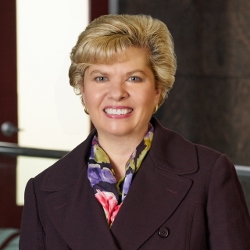Institutional Investor is proud to recognize leaders within the allocator community for their outstanding contributions to portfolio construction at the second annual AlphaEdge Recognition Dinner. Prior to the event, we sat down with Valerie Sill, CFA, CAIA, recognized in the category of Most Influential Women in Investment Management.
Valerie is an industry veteran, having held the role of President and CEO since 2004. At the corporate pension fund in Wilmington, Delaware, she oversees the investment of over $15 billion in assets held by DuPont Company plans. Valerie chairs the Board of Directors of the Chartered Alternative Investment Analyst Association (CAIA) and serves as an Independent Trustee for Wilmington Trust’s Fund Board. She is a member of the Board of Trustees of Longwood Gardens and chairs its Investment Committee.
She first entered the investment industry as a buyside analyst at State Street Research & Management. Valerie later joined The Boston Company Asset Management, where she spent a decade across three roles, including two years as Director of Research, six as Senior Vice President and Portfolio Manager, and two years as Executive Vice President.
Valerie is a graduate of Wellesley College, where she received her bachelor’s degree in Economics and Philosophy, and of Harvard Business School, where she earned her MBA. Valerie holds the CFA and CAIA charters.
The following has been edited for length and clarity.
What is the biggest challenge facing the industry today?
 We’re living in a very challenging investment environment. Stock market concentration has increased dramatically over the last 15 years. U.S. equity markets have significantly outpaced other regions since 2009 and now hold an unprecedented and dominant share of over 50% of world equity markets. The technology sector dominates stock market returns across the globe which has created undue stock and sector concentration. Large companies dominate across most regional indices. This concentration of assets and returns presents challenges for active management and risk management, making it incredibly difficult to generate sustained excess returns and to control portfolio risks appropriately.
We’re living in a very challenging investment environment. Stock market concentration has increased dramatically over the last 15 years. U.S. equity markets have significantly outpaced other regions since 2009 and now hold an unprecedented and dominant share of over 50% of world equity markets. The technology sector dominates stock market returns across the globe which has created undue stock and sector concentration. Large companies dominate across most regional indices. This concentration of assets and returns presents challenges for active management and risk management, making it incredibly difficult to generate sustained excess returns and to control portfolio risks appropriately.
This unprecedented level of concentration has driven a surge in passive investing, which ironically sets the stage for fundamental analysis, and ultimately active management, to shine. The macroeconomic backdrop of tough-to-tame inflation, coupled with higher levels of interest rates for the foreseeable future, will lead to a bifurcation of returns across sectors and regions, and therefore, a different type of leadership within the market and different sources of risk to manage. Insightful fundamental analysis can identify which companies are able to maintain profitability in the face of rising costs and withstand higher financing costs and, alternately, indicate which companies will not do well and may not survive under these conditions.
Now everyone is using AI to try to determine that.
AI tools are valuable and continue to evolve. One of their biggest limitations is that many of these tools use backward looking data to make judgments. This creates the risk of perpetuating analytical biases. More often than not, the most recent information, and hence more valuable information, is not incorporated.
As portfolio managers, we basically deal in risk and probabilities, and this trade-off is different for every portfolio, pension plan, and/or asset owner. This is why I believe human judgement will always be critical. AI tools can be employed to enhance productivity, for example by narrowing your focus within the universe of securities you’re analyzing, but they can’t replace qualitative judgement.
Who were your mentors and what made you go into your current job?
I’m fortunate to have had a lot of mentors. Reflecting back on my Wellesley College years, Karl “Chip” Case was an important mentor. I took Chip’s introductory Macroeconomics class, loved the subject and decided to also major in Economics along with Philosophy. Chip really inspired me to become an economist, which gave me the analytical and quantitative skills to become a buyside equities analyst and ultimately a CIO.
My first job in the industry was with State Street Research & Management (SSR&M) Company. There I met two important mentors – John Phillips and Michael Yogg – who both taught me the fundamentals of securities analysis. Veteran value investor, Lew Sanders, always had an influence on my style of investing: We implemented his dividend discount model approach at SSR&M, at The Boston Company, and have used it at DuPont Capital Management. At DuPont Capital, I had a great advisory council whose members included Lew, Peter Aldrich, John Castle, Art Laffer, and Rusty Olson. All of these great thought leaders inspired my vision for DuPont Capital and made me a better investor.
If you weren’t in investment management, what would you be doing?
I think I would have become an attorney, probably an M&A lawyer. I designed my college curriculum to prepare for law school; however, after interning at a law firm I discovered I just wasn’t passionate about legal analysis, so I went down the path of becoming a global economist and ultimately an institutional investor. I’m so grateful I went down this path.
What is an attainable thing the industry can do to improve the sector?
I think plan participant education should be improved: This country faces a retirement crisis, and I think many participants don’t have sufficient investment knowledge or investment tools and product offerings to assist them with achieving their goals.
Each defined contribution plan is unique and different. There have been some great innovations that have enhanced participants’ probability of success. Target date funds offer age-appropriate asset allocations that automatically adjust each year. White-label, multi-manager separate accounts are designed to incorporate a mixture of manager styles with the goal of muting the volatility of returns to improve compounded return streams over time. However, obstacles remain to offering participants a full range of investment options, particularly private fund investments, due to regulatory issues and product complexity. More work should be done to improve the menu of investment options available to defined contribution participants.
For more content of Investor Week, visit the group here.
To discuss the content of this article or gain access to like content, log in or request membership here.

